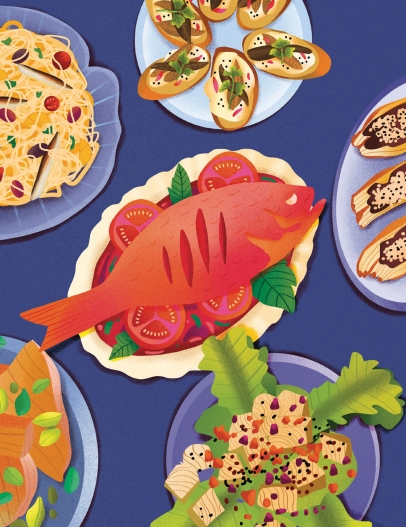The Feast of a Few Fishes
In lieu of nutmeg, cinnamon, or cloves, my Christmas Eves tasted of a particular brine: anchovies, black olives, and cod fish. Every December 24th, my family begins the evening with a dinner of two seafood dishes before attending Christmas Eve Mass: linguini in oil with anchovies, which we call “macaroni in oil,” and cod fish in tomato sauce, known as baccalá. It is the most distinct and consistent meal in my life, and the reason I cherish Christmas Eve over Christmas Day.
I’ve spent every Christmas Eve in Oklahoma City, but our meal transports me to the hilly, papermill town of Johnsonburg, Pennsylvania, recounted in the “back in those days” stories my father tells about his childhood. Following Catholic custom, they abstained from eating meat before midnight mass, so my grandmother cooked macaroni in oil and baccalá for her family of 16 each Christmas Eve. After dinner, they sat around the table eating fruit from a large dish and singing Christmas carols. My grandfather passed around pieces from walnuts he cracked open with his bare fists. Some of the kids would sing in the choir during midnight mass that evening, which was held in the basement of the Catholic school down the street — and still conducted in Latin.
Afterward, a late-night party ensued at their house. The oil from the linguini dish lined stomachs for a night of drinking, eating meat, and celebrating the arrival of Christmas Day with neighbors and friends.
My Christmas Eves have always been quieter; just my mother, father, and me. We made it our own, and just as special. My father would walk me through his mother’s recipe, and once the tomato sauce hit the stove in the afternoon, it filled the house with a dense, fruity aroma, and I knew Christmas was near. Over time, my mother, who is first-generation Korean, took the lead on cooking, memorizing the recipe and perfecting the dish. It became her own.
Both dishes revel in warmth and heat. Hot tomato sauce, once trapped, is released from the pitted holes of black olives and the soft flakes of cod, the latter of which breaks into small chunks at the lightest push of a spoon. With each twist of a fork, flakes of black and red pepper cling to twirling linguini doused in crackling hot oil, allowing the fork’s holder to select the appropriate amount of heat for the mouthful. Add a long loaf of Italian baguette to soak up what remains. As a child, I struggled to eat the pungent anchovies. I was too young to appreciate the complex flavor created as they dissolved in the oil, not knowing it could never be achieved with salt alone. Now, I go through anchovies by the tin.
My father and aunt had never heard of it when I asked, and I was 20 before I learned of the traditional Italian-American “Feast of the Seven Fishes,” and realized our custom was its slimmed-down, once removed cousin. The full version includes cod, shellfish, eel, squid, and clams. Reimagined, modern takes use anything from fried oysters to shrimp cocktail. When I asked my father why our customary meal included only two of the seven fishes, he answered, “Growing up, it was all we could afford.” This economy is found in my grandmother’s notes accompanying the recipe: “Squeeze out all anchovy tin oil into the oil and water.”
Our tradition began with my great-great-grandparents, who emigrated from Naples, Italy. Yet, the Feast of the Seven Fishes is more Italian-American than Italian-Italian. The custom made sense — a workaround to celebrate Christmas Eve without sacrificing pasta and tomato sauce. Maybe someday, in the distant future, I’ll cook a complete Feast of the Seven Fishes. But not any time soon.





